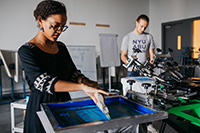-
Academics
-
Admissions
 Your journey to NYUAD starts here. Attend an application workshop or information session.Admissions Events
Your journey to NYUAD starts here. Attend an application workshop or information session.Admissions Events -
Research
-
Campus Life
 Live the possibilities. Be part of a dynamic community of students from over 115 countries.Take a Tour
Live the possibilities. Be part of a dynamic community of students from over 115 countries.Take a Tour - Public Programs
-
About
Exceptional education. World class research. Community-driven.Our Story
- News
- Events
- Social Media Directory
- Press Room
-
- Torch at NYUAD
- Faculty
- Current Students
- Alumni
- عربي
Development of Novel Low Biofouling Materials for Membranes for Water Treatment
Biofouling in membranes is initiated by the adsorption of a hydrophobic matters on the membrane surface which results in a massive growth of microorganisms in the form of biofilms. Those foulant matters block the pores of the membrane and result in reduced flux of treated water.
Understanding the mechanism of the initial attachment prior to biofouling is a key point in eliminating the biofouling on membrane surfaces. The objective of this work is to prepare membrane materials that have the ability to suppress the initial attachment of foulants rather than dealing with the biofilms after they have already formed.
Several polymeric films will be tested in terms of their Hansen Solubility Parameters, their adsorption and adhesive characteristics to some bio-foulant models such as alginate, bovine serum albumin and humic acid. Possible correlation between HSP, adhesive forces and adsorption of bio-foulants to surfaces are also investigated. Screening and categorizing the different polymeric membranes or polymer blends that can result in the lowest affinity to biofouling will be considered for further investigation as candidate materials for biofouling mitigation.
